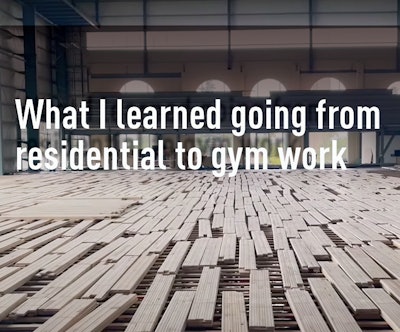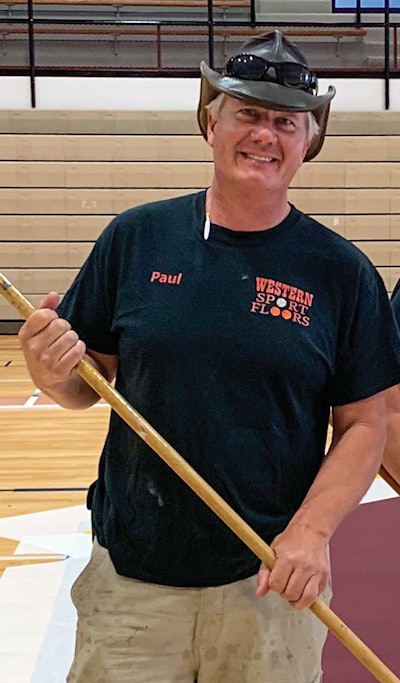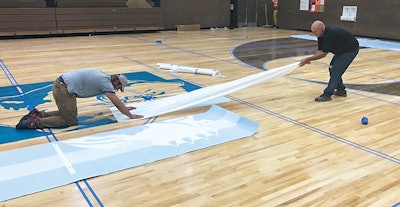

I had been in the residential wood flooring business for about 10 years when the Great Recession hit, and we started doing gym floors just to stay in business. A few years later, we purchased our biggest gym floor competitor, and we’ve never looked back! Today we have three to four crews traveling throughout the Rocky Mountain West doing sports floors, and it’s a business I’m passionate about.
In the following pages I explain some of the things I learned about making the transition from residential work to gym floor jobs. This description will only scratch the surface of the many facets of commercial construction; installing a gymnasium floor in a large commercial project is as different from installing residential wood floors as it is different from doing roofing. The actual work is not that different, but in commercial construction, process is key. The process and administration must be attended to! My goal is not to discourage anyone, just to shed some light on the process. The installation of gymnasium floors (like anything else in life) has abundant opportunities for any ambitious individual willing to serve their customers with high-quality products!
Bidding jobs: residential vs. commercial
In my experience, when dealing with a homeowner, it is very important to build trust. The contractor is, after all, coming into the homeowner’s home and staying for some period of hours and days, often without the homeowner being home. So, it is understandable that the homeowner would want to know references and background information about the contractor. A contractor needs to connect with the homeowner at some level, putting the homeowner at ease about the contractor’s ability to perform the job, and then, finally, show the homeowner a written estimate clearly defining the work to be done and the exact price.
Throughout this process, the homeowner and the contractor develop a relationship of mutual trust. The homeowner is trusting the contractor to come into their home and do a neat, precise, professional job in the time frame that the contractor said they would do it in. The contractor is trusting the homeowner to give them reasonable access to the job site, to have some understanding of small changes and inevitable challenges that may arise, and, finally, to pay the contractor in full when the job is complete.
 Your submittal will need to detail every single product you intend to use on the job, from sandpaper to paint.
Your submittal will need to detail every single product you intend to use on the job, from sandpaper to paint.If the contractor has done what they said, and the job has been completed on time and the customer is happy, the customer is usually appreciative and thankful for the job. In my experience, this becomes part of the payment for the job. Customer appreciation, positive reviews, and the referral of friends is a natural part of a job well done (of course, not every customer is a good customer, and some are very hard to please). However, in general, if the contractor is honest and does what they say they will do, most customers will be appreciative of the work performed and will pay promptly.
 It will likely be one to two years after you bid the job before you are delivering material to the job site—and you must stick with the price you bid at that time.
It will likely be one to two years after you bid the job before you are delivering material to the job site—and you must stick with the price you bid at that time.Now enter into the commercial realm: GCs who build schools, civic centers, college campuses, and other large projects where a gymnasium is to be installed are going to be large, well-established organizations.
In order for a flooring contractor to bid a gym flooring project, it usually requires using some kind of plans service. These are usually subscription-based plans in which you pay a fee to get access to even bid the work. The GCs will sometimes be helpful if you have questions about the bid, but in my experience, usually they are not.
They are trying to get bids together from dozens of subcontractors on a multi-million-dollar project. Answering a question from a subcontractor who cannot determine whether the architect is calling for 1st grade or 2nd-and-better maple is low on their priority list. Sometimes the architect can be helpful, but this is hit or miss, as well.
We are a well-established gymnasium flooring company, and we expect to win only 20–40% of the jobs we bid on. The plans are complicated (as mentioned above, sometimes vague), and it is time-consuming to determine what you are being asked to bid. The bidding process, like everything else we do, takes time and experience to learn. In many instances, after hours of hard work on a project, someone else will be awarded the contract.
Dealing with contracts
Once a bid has been submitted, it may take the GC a couple of weeks to a couple of months to get around to notifying the subcontractor that they are being awarded the project. If you have never worked for a particular GC before, expect to go through some kind of pre-qualification process before being given a contract to do the work.
When your contract arrives, read it carefully. If you disagree with any of the provisions in the contract, the GC may agree to change that provision. More likely they will just offer the contract to another subcontractor (welcome to the world of commercial construction!).
Upon signing the contract, you will be asked to send in a submittal. This is information about all of the supplies to be used in the installation and finish work on the gym floor, such as the type of gymnasium floor system, type and grade of maple, sandpaper, paint, base cove, threshold, and so on. The submittal needs to match the detail called for in the original plans and specifications that were the basis of the bid.
At some point, likely 12–24 months after the project was bid, it will be time to deliver the gymnasium flooring material to the job site. The GC doesn’t care if prices have gone up in the meantime, you will be expected to perform the job at the price you bid.
As a residential contractor, you may work with only one or two people per job. On a gym floor project, you will deal with many people. The GCs, estimator, project manager, job site superintendent, project engineer, architect, interior designer … the list goes on.
RELATED: How They Do It: Pulling Off Today’s Bold Basketball Floors
How to get paid
The wood flooring contractor who wants to enter the world of commercial installations will need administrative help to navigate the dozens of logistical details necessary to do this type of work. The most important one is, not surprisingly, getting paid.
A GC will usually accept a pay application only once a month, typically toward the end of the month. The subcontractor can bill for the work that has been done throughout the month. The GC will then bill the owners around the first of the month. Once the owner has paid the GC, they will pay the subcontractors. It is typical to wait 60–90 days after the work has been completed to be paid. We have often completed a gymnasium flooring project before being paid for the materials. This is annoying, but it is the way it is. Plan for it!
 Even though you may be dealing with large amounts of materials, you need to be prepared to not be paid for them until, potentially, after the project has been completed.
Even though you may be dealing with large amounts of materials, you need to be prepared to not be paid for them until, potentially, after the project has been completed.Know your bonding
Bonding is like insurance. There are bid bonds and performance bonds.
A bid bond guarantees compensation to the bond owner if the bidder fails to start a project.
A performance bond, also known as a contract bond, is issued by an insurance company or a bank to guarantee satisfactory completion of a project by a contractor.
Typically, a contractor must show some history of ability to complete a project of the size and scope they are trying to get bonded for. This creates a catch-22 for a contractor new to a certain area of work. If you need a bond to do the work, how can you prove you can do the work if you cannot get the bonding. Like anything else, you need to start small and work your way up. Like insurance, bonding becomes much more expensive (or possibly impossible) to obtain if you ever have a claim. If you are bonded on a job, you better do it right!
Gym floors often require travel
Depending on geographic location, many gym floor contractors do a lot of travel. However, if a person lives in a large metropolitan area with hundreds of gyms in a relatively small area, this may not be an issue. Located where we are in Montana, we travel constantly, so hotel bills, vehicle expenses, fuel and other related travel costs add to our price for gym floor work.
 Getting bonded for the first time can be a catch-22, because you must demonstrate a history of being bonded for larger projects.
Getting bonded for the first time can be a catch-22, because you must demonstrate a history of being bonded for larger projects.Insurance: lots of it
A gym flooring contractor needs lots of insurance. Workers compensation insurance, liability insurance, vehicle insurance, unemployment insurance, umbrella insurance and, as mentioned above, bonding. When working for a GC, expect lots of requests to your insurance agent for insurance certificates (basically, proof of insurance), requests for subrogation clauses, and so on. Insurance costs money, and these costs need to be built into the cost of the work.
 Many gym jobs today involve an interior designer, with specifications for exact paint colors that fit into the overall design vision for that gym.
Many gym jobs today involve an interior designer, with specifications for exact paint colors that fit into the overall design vision for that gym.A word on quality
“The only thing a good contractor leaves behind is the quality of work that they do.”
The gym floor community is small. Athletic directors talk, coaches talk, maintenance people talk, principals talk. If a contractor does good work, people will talk. If a contractor does poor quality work, people will talk more! Generally, when you do a good job, no one says anything, and when you do a bad job, they shout it from the rooftops! That is a fact, don’t let it bother you. Commit to doing great work, and if you make a mistake, go back and fix it! Quality work is just a matter of making up your mind to do quality work. Do not focus on profit! Focus on quality, because profit follows quality.
Early in my career I had a mentor named Randy Nash of R&R Hardwood out of Boise, Idaho. Randy said this: “When you make mistakes (and you will make mistakes), and have customers that are not entirely happy with your work, if you have the integrity to go back and fix the problem, you will gain more respect and rapport with that customer than if you had just done the job right in the first place.”
Of course, the goal is always to do the job “right” the first time. However, everyone has problem jobs, and in the beginning of any career, you probably won’t have to wait long for one. The question is: Will you do the right thing? Doing the “right thing” is making the customer happy! This is the basis of quality work.
Part of ‘quality’: Giving the customer what they want
Let me say one more thing about “quality” work. What is quality work? The old saying goes, “Beauty is in the eyes of the beholder.” As a contractor, we work for the customer. In gym work, sometimes it’s easy to lose sight of who the customer is. On a new construction project, the gymnasium flooring contractor is working for the GC. An architect is overseeing the building design, an engineering firm is overseeing structural design and there may also be an owner’s representative. On some projects there are other consultants, like an interior designer. All of these people and their companies may have some input on the gym floor installation and finish. Ultimately the facility owner, which is the school district, college, or municipality, is paying the bills.
In a situation like the one outlined above, it is almost impossible to have any communication with the people who actually own the facility. Even though the gym floor contractor is the “expert” in maple gymnasium flooring, in most cases you will not be asked to provide a recommendation. As an example, the interior designer will choose paint colors for the game lines on the gymnasium court. Maybe what the designer is trying to accomplish is to match a color scheme throughout the building. He or she doesn’t care what color you normally paint auxiliary basketball lines. As an example, if they want Sherwin-Williams SW1084 Dunes Tan, you need to figure out how to give them that color. Giving the customer what they want is part of doing quality work. Following directions from the people the customer hires to give them what they want is part of the job.
This is a fine line. Sometimes what the customer wants doesn’t make sense, or it is not possible or is not a good idea. Sometimes, however, it’s good to just stop and ask yourself: Is this really that big of a deal? If the customer has been using ABC finish, but I like XYZ finish, does it really make that much difference? As a gym floor contractor, you should be comfortable using a variety of products and finishes. In my experience, if a customer really wants a certain product, give them that product! If a customer has a strong preference for one brand of finish over another, as long as it’s approved by MFMA, give the customer what they want. If a customer wants a certain design on their gym floor, but you think it looks silly, you can make gentle suggestions, but in the end, it’s their gym floor. Part of doing quality work is giving the customer what they want. Do not fight with your customers! It will not end well for you!
 You need to be prepared to use whatever finish is specified—giving the customer what they want is part of doing a quality job.
You need to be prepared to use whatever finish is specified—giving the customer what they want is part of doing a quality job.Pricing structure
The more established your company becomes, and the more known for quality your company becomes, and the more reliable your company becomes, the less pricing will matter to your customers!
It is extremely important to give your customers value. Value goes way beyond the price of your service. Did you show up on time? Did you conduct yourselves as professionals? Did you do what you said you were going to do? Were you reasonable and easy to deal with? Did you notice that none of these questions dealt with how the project looked?
Your projects need to look great, but quality goes well beyond that simple standard. Gymnasium flooring contractors are working (in most instances) for public entities. By definition, these jobs tend to be somewhat political. If you embarrass the people you are working for in a public entity, you endanger their jobs! If you showed up late, completed the job late, had guys smoking in the back of the school (it’s illegal in all 50 states to smoke on school property), then you did poor-quality work, regardless of what the gym floor looked like.
By contrast, if you show up on time, complete the job when you said you would, and charge the customer what you bid, now you are on the way to doing good-quality work. Now if the floor looks great, the customer is satisfied. Don’t look for a big slap on the back; this is what they expected when they hired you!
Word will get around when you do quality work. Price will become secondary in some cases. No one gets every job they bid (or if they do, they aren’t bidding enough work)! Don’t worry a bit about the jobs you don’t get. There is always another job; go bid some more. Meet some new potential customers. It’s a big world out there!
Our company works almost exclusively for K-12 public schools. We do jobs for colleges, rec centers, private schools, churches, and so on. However, nine out of 10 jobs that we do are for K-12 public schools. So, everything we do is catered to the needs of K-12 public schools. We know that technically we need to be the low bidder, but our focus is on providing a level of value and service to our customers such that they still choose us sometimes when we are NOT the low bidder.
We have a pricing structure that works for us. We travel throughout the Rocky Mountain West. Many times, when we dispatch a crew to go to a job, they are traveling four to nine hours just to get there. Our jobs usually entail hotel stays, fuel for the trucks and food for the crew, as well as insurance, snowy mountain passes, and other challenges too numerous to articulate. We need to build in these expenses for every job we bid.
Every contractor is going to have a different pricing structure, because every contractor is going to have a different customer base and situation. A contractor who provides value to their customers is a valuable entity!













































